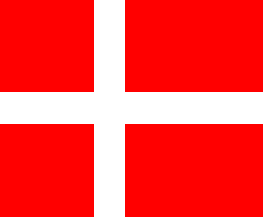 |
 |
November 2018 |
Wednesday 28 November 2018
We arrive at Amsterdam Airport Schiphol at around 8.45am. It is
extremely quiet at the SAS baggage drop-off desk. There is no one in
ahead of us. We walk through the security check, which is very thorough
today. After that we drink coffee at Starbucks and go to gate C07 for
our SAS
flight to Copenhagen. The flight leav es
on time and is far from full. We arrive in Copenhagen on time. It is a
long walk to the baggage claim area. We wait for 5 minutes for our
suitcases and then continue towards the metro station. The unmanned metro
leaves fairly quickly and within 15 minutes we are at Nørreport station
in the middle of the city. There we get on the bus to our apartment in Nørrebro,
just outside the center, opposite the Rigshospitalet (University Medical
Center).
es
on time and is far from full. We arrive in Copenhagen on time. It is a
long walk to the baggage claim area. We wait for 5 minutes for our
suitcases and then continue towards the metro station. The unmanned metro
leaves fairly quickly and within 15 minutes we are at Nørreport station
in the middle of the city. There we get on the bus to our apartment in Nørrebro,
just outside the center, opposite the Rigshospitalet (University Medical
Center).
Our Airbnb
apartment is larger than expected and well furnished. We immediately go
shopping at a small Irma
supermarket inearby. Then we have lunch at the apartment. After lunch
and a short break, we take the bus and metro to Kongens Nytorv.
From the metro we end up in the Magasin
du Nord department store. This 150 year old shoppers' paradise
exudes luxury. Literally because the facade is completely decorated with
string lights. From there we walk towards the harbor and the Royal
Library. A modern extension was built to the Library in
1999, designed by architects Schmidt Hammer Lassen. It is a black
cube-shaped building covered with granite slabs. Hence the nickname the
Black Diamond. We drink coffee in the café øieblikket (the moment) and
then look around in the new building and the old building. The new
building is divided into two by an atrium with a stairwell that leads to
the level where a bridge c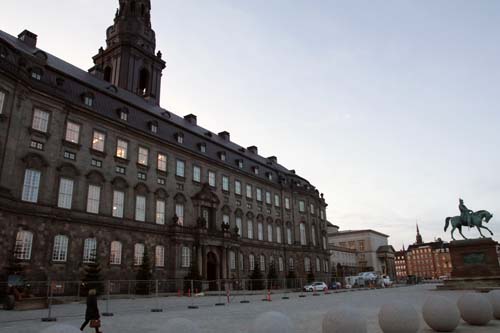 onnects
to the old building. On the right is an auditorium, Dronningens Sale. On
the left are reading and study rooms, which get daylight through the
atrium. There is also a photo museum and a cartoon museum.
onnects
to the old building. On the right is an auditorium, Dronningens Sale. On
the left are reading and study rooms, which get daylight through the
atrium. There is also a photo museum and a cartoon museum.
After the library we walk through Christiansborg,
the government center into the old city. It is also known from the
television series Borgen.
We walk across a Christmas market and then arrive at Illums
department store. Also a luxury buying paradise, but something more
modern than Magasin du Nord.
Then we walk on to the Købmagergade, which crosses Valkendorfsgade. The
latter is a part of Strøget, the first pedestrian shopping street in
Denmark. We pass the round tower (we save for tomorrow) and arrive at
Nørreport. There we buy bread at the bakery and continue to the Torvehallerne
(Market Halls). These halls, designed by the Danish architect
Hans Peter Hagens (ApS), were first opened in 2011. They are two halls
with an open air market in between where the vegetable market once was.
Exclusive foods are sold and eaten in the halls. We eat delicious
smørrebrød (with salmon and herring respectively). Later in the evening
we go out to The
Barking Dog, a cozy cocktail bar in the neighborhood.
Weather: dry, slightly cloudy with sunny periods. 4 ° C
Thursday 29 November 2018
We get up fairly early, around 7.45. It's raining outside. After
breakfast we walk along the Lake Sortedam in the full wind and rain to
the Lagkagehus,
a branch of a coffee shop, bakery and pastr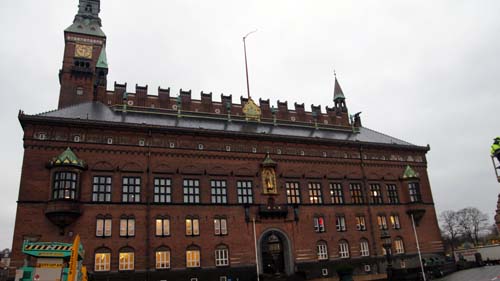 y
chain. We get a little bit drenched. We dry up over a large coffee and
when we leave the shop again, it there is still a light drizzle. We
cross the Queen Louise bridge and take bus 5C to the Town Hall Square.
We take a look at Copenhagen
City Hall. The enormous building with its characteristic
tower is an example of the National Romantic style, which was popular in
Scandinavia at the end of the 19th and beginning of the 20th century.
Architect was Martin Nyrop. The building was completed after 9 years of
construction in 1905. Behind the entrance you enter a large hall lined
with Danish flags. On the second floor is a arched gallery and below
historical Copenhagen events are written in mosaic. On the second floor
there is also a party room, but unfortunately it is not accessible
today. After the town hall we continue on Strøget. This is
Denmark's first pedestrian shopping street. Actually, it is a chain of
streets. We pass a Lego
Flagship store and then at the store for Royal
Copenhagen (ceramics and crockery). It is all beautiful, but also
very expensive. We continue and after a coffee stop at the bea
y
chain. We get a little bit drenched. We dry up over a large coffee and
when we leave the shop again, it there is still a light drizzle. We
cross the Queen Louise bridge and take bus 5C to the Town Hall Square.
We take a look at Copenhagen
City Hall. The enormous building with its characteristic
tower is an example of the National Romantic style, which was popular in
Scandinavia at the end of the 19th and beginning of the 20th century.
Architect was Martin Nyrop. The building was completed after 9 years of
construction in 1905. Behind the entrance you enter a large hall lined
with Danish flags. On the second floor is a arched gallery and below
historical Copenhagen events are written in mosaic. On the second floor
there is also a party room, but unfortunately it is not accessible
today. After the town hall we continue on Strøget. This is
Denmark's first pedestrian shopping street. Actually, it is a chain of
streets. We pass a Lego
Flagship store and then at the store for Royal
Copenhagen (ceramics and crockery). It is all beautiful, but also
very expensive. We continue and after a coffee stop at the bea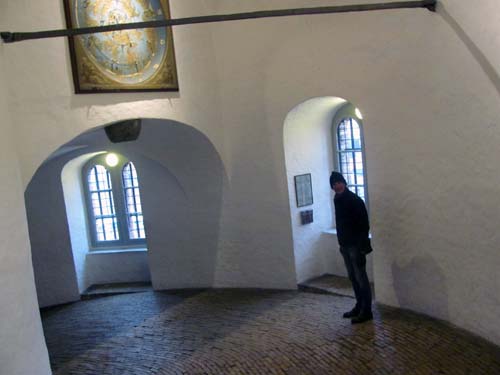 utiful
café Norden we
arrive at the Round tower (Rundetårn),
which was completed in 1642 by order of King Christian IV by the Dutch
architect Hans van Steenwinkel de Jonge. The tower is 42 meters high and
functions as a church tower and observatory. The way up is not by
staircase, but a ramp that turns 7.5 times around its axis. Peter the
Great visited the tower on horseback in 1716. In 1902 a car drove up
(and back again) for the first time. Once up we are in the full wind and
it is freezing cold (wind chill factor -4 °). The view over the city is
beautiful. Few high-rise buildings and the skyline is dominated by
church towers. For example the one of the Vår Frelserkirke with
the stairs on the outside of the spire. Downstairs we eat an organic and
ecologically correct Danish Hotdog from Døp.
We then walk to Vor Frue Kirke (Our Lady's Church), the
cathedral church of Copenhagen. The neo-classical church was completed
in 1829 on the site where the main church of Denmark had stood for
centuries, but which had been set on fire by the
utiful
café Norden we
arrive at the Round tower (Rundetårn),
which was completed in 1642 by order of King Christian IV by the Dutch
architect Hans van Steenwinkel de Jonge. The tower is 42 meters high and
functions as a church tower and observatory. The way up is not by
staircase, but a ramp that turns 7.5 times around its axis. Peter the
Great visited the tower on horseback in 1716. In 1902 a car drove up
(and back again) for the first time. Once up we are in the full wind and
it is freezing cold (wind chill factor -4 °). The view over the city is
beautiful. Few high-rise buildings and the skyline is dominated by
church towers. For example the one of the Vår Frelserkirke with
the stairs on the outside of the spire. Downstairs we eat an organic and
ecologically correct Danish Hotdog from Døp.
We then walk to Vor Frue Kirke (Our Lady's Church), the
cathedral church of Copenhagen. The neo-classical church was completed
in 1829 on the site where the main church of Denmark had stood for
centuries, but which had been set on fire by the British in the Napoleonic War in 1807. It is a sober church, but very
stylish with a neo-Greek / Roman facade of columns. Inside, attention is
drawn to the blessing Christ in the Apse by Bertel Thorvaldsen. He also
did the 12 apostles who are placed on both sides of the church.
British in the Napoleonic War in 1807. It is a sober church, but very
stylish with a neo-Greek / Roman facade of columns. Inside, attention is
drawn to the blessing Christ in the Apse by Bertel Thorvaldsen. He also
did the 12 apostles who are placed on both sides of the church.
After the church visit we walk to the bus stop and ride back to the
apartment. We have lunch and in the afternoon we head off to Ny
Carlsbergs Glyptotek, a museum that originated from the art
collection of Carlsberg brewer Carl Jacobsen (1842-1914). From 1882
Jacobsen opened his collection to the public at home, but in 1888 the
collection became so extensive that a special building was needed.
Jacobsen handed over part of his collection to the city and the state,
provided that a special building had to be built to house it. It was
opened in 1897. An extension followed in 1906. The collection consists
of an enormous number of Greek and Roman statues and especially busts.
Furthermore, Danish paintings from the Danish Golden Age from the late
18th century to the second half of the 19th century. A large number of
works from that period are on the second fl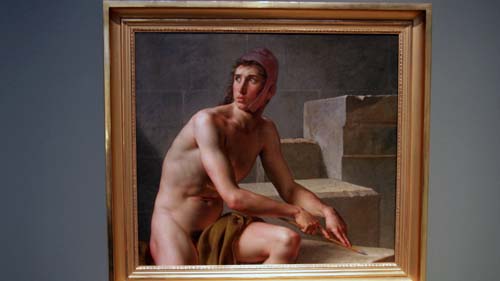 oor.
We see many landscapes by painters unknown to us from realism to
impressionism. Also a large amount of French painters and bronze
sculptures by Degas on the top floor. The museum is situated around a
glass roofed winter garden. After the museum visit we go back and we eat
"at home".
oor.
We see many landscapes by painters unknown to us from realism to
impressionism. Also a large amount of French painters and bronze
sculptures by Degas on the top floor. The museum is situated around a
glass roofed winter garden. After the museum visit we go back and we eat
"at home".
In the evening we go out to visit some Gay bars. We start at Centralhjørnet,
the oldest existing gay bar in Denmark and perhaps in the world. It is
packed. Very noisy and people still smoke here. After a 15 minutes we
have had enough and walk on to Oscar,
a trendy and friendly bar that fittingly situated at the Regnbuepladsen
(Rainbow Square). There is no smoking here, the music is played at a
pleasant volume and the atmosphere is calm.
Then we take bus 6A back to Nørrebro, where our apartment is located.
Weather: rain and strong breeze, 2 ° C
Friday 30 November 2018
After breakfast we take a Bycyklen
rental bike from the stand at Rigshospitalet. We head for the old
center. We join the morning rush hour and it is very busy on the (wide)
bicycle lanes. The cyclists in Copenhagen ride fast and have an
assertive cycling style. Everyon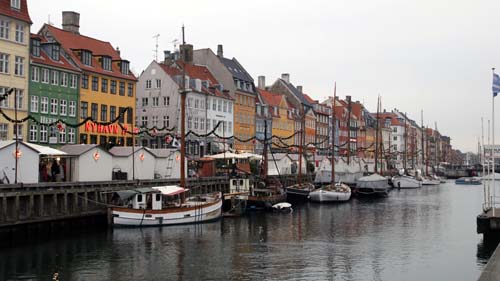 e
overtakes everyone - even the delivery bikes. We are going for cake and
pastry at conditori La
Glace. It has a beautiful classic ambiance (since 1870) and the
cake is delicious. From there we cycle to Nyhavn. We walk around
this old harbor with the beautiful houses, where fairy tale writer HC
Andersen once lived. The colorful facades around the 17th century harbor
are picture perfect and a real tourist attraction. That has not always
been the case. In the 70s and 80s of the last century, Nyhavn descended
into a red-light district with seedy brothels and bars. From that time
there is just one left. The contrast with the atmosphere of today could
not be greater. There is a Christmas market on one of the quays. We
continue to Amalienborg
the palace of the royal
family in winter time. The complex consists of four identical
buildings, symmetrically arranged around an equestrian statue. They were
bu
e
overtakes everyone - even the delivery bikes. We are going for cake and
pastry at conditori La
Glace. It has a beautiful classic ambiance (since 1870) and the
cake is delicious. From there we cycle to Nyhavn. We walk around
this old harbor with the beautiful houses, where fairy tale writer HC
Andersen once lived. The colorful facades around the 17th century harbor
are picture perfect and a real tourist attraction. That has not always
been the case. In the 70s and 80s of the last century, Nyhavn descended
into a red-light district with seedy brothels and bars. From that time
there is just one left. The contrast with the atmosphere of today could
not be greater. There is a Christmas market on one of the quays. We
continue to Amalienborg
the palace of the royal
family in winter time. The complex consists of four identical
buildings, symmetrically arranged around an equestrian statue. They were
bu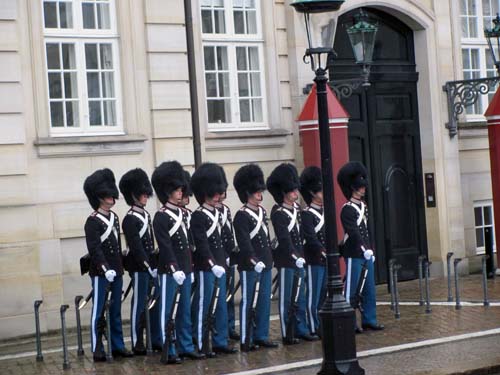 ilt
in 1750 for four noble families. The royal family expropriated the
houses in 1794 when their own palace, Christiansborg burned down . The
standard of both the queen and the crown prince is in top, which means
that they are at home. One of the palace buildings have been turned into
a museum. At 12 o'clock the changing of the guard begins. That is when
it also starts to rain. The ceremony is a time-consuming thing, but the
guards with their bears' hats is a beautiful sight. After the ceremony
we walk to Ida Davidsen, but this smørrebrød restaurant is fully booked.
We end up at Amadeus,
where we also eat a delicious smørrebrød.
ilt
in 1750 for four noble families. The royal family expropriated the
houses in 1794 when their own palace, Christiansborg burned down . The
standard of both the queen and the crown prince is in top, which means
that they are at home. One of the palace buildings have been turned into
a museum. At 12 o'clock the changing of the guard begins. That is when
it also starts to rain. The ceremony is a time-consuming thing, but the
guards with their bears' hats is a beautiful sight. After the ceremony
we walk to Ida Davidsen, but this smørrebrød restaurant is fully booked.
We end up at Amadeus,
where we also eat a delicious smørrebrød.

Then we walk to the Designmuseum.
A lot of furniture there, especially chairs of Danish make. Also fashion
and utensils. We get back on the bike, now to the Little Mermaid or
Lille Havnfrue. The little statue of the mermaid from Andersen's fairy
tale. Many tourists take their picture with it. The statue has been here
since 1913 and was a gift by Carlsberg to the city. It was decapitated a
few times as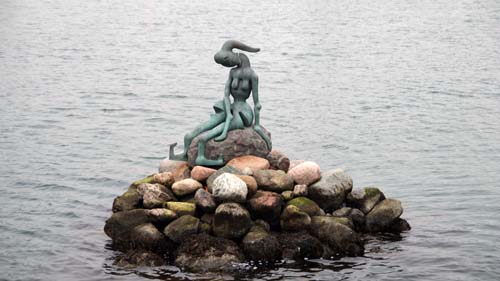 a bad joke, but fortunately restored again. We cycle further to the
statue of the alternative mermaid. It is on its own island in front of
the Pakhuskaj and is part of the "Genetically Modified Paradise" by
artist Bjørn Nørgaard.
a bad joke, but fortunately restored again. We cycle further to the
statue of the alternative mermaid. It is on its own island in front of
the Pakhuskaj and is part of the "Genetically Modified Paradise" by
artist Bjørn Nørgaard.
In the evening we eat at 108
in Christianshavn. The chef learned his trade at Noma - one of the best
restaurants in the world - and has cooked one star of Michelin together.
We have a delicious 8 course dinner with matching wines. The restaurant
is not fancy, but it is good. After dinner we take a taxi home.
Weather: cold and wind. 2 degrees.
Saturday 1 December 2018
We take the bus and the S-tog (train) to Vesterport station. From there we walk a short distance
to Sixt car rental.
We get an upgrade from an Opel Corsa to a BMW 1-series. We buy a return
ticket for the Øresund
bridge online and drive towards Sweden through the long tunnel and over
the bridge over the Sound. The tunnel was opened in the year 2000 and
has since formed the permanent link between Denmark and Sweden.
The total route is 8km long. The train runs underneath the car bridge.
At the toll booth on the Swedish side of the bridge we take the green
lane and can continue to passport control, which Sweden (temporarily)
has set up during the 2015 refugee crisis. In Malmö we first
visit the Lilla Torg, the small market square, where we drink a cup of
coffee at Café
Pronto between half-timbered houses. We walk to the large market
square (Stortorget). This square was the largest square in Northern
Europe in the 16th century. The town hall from the 18th century with a
Dutch Renaissance façade is on the East side of the square. We also see
S-tog (train) to Vesterport station. From there we walk a short distance
to Sixt car rental.
We get an upgrade from an Opel Corsa to a BMW 1-series. We buy a return
ticket for the Øresund
bridge online and drive towards Sweden through the long tunnel and over
the bridge over the Sound. The tunnel was opened in the year 2000 and
has since formed the permanent link between Denmark and Sweden.
The total route is 8km long. The train runs underneath the car bridge.
At the toll booth on the Swedish side of the bridge we take the green
lane and can continue to passport control, which Sweden (temporarily)
has set up during the 2015 refugee crisis. In Malmö we first
visit the Lilla Torg, the small market square, where we drink a cup of
coffee at Café
Pronto between half-timbered houses. We walk to the large market
square (Stortorget). This square was the largest square in Northern
Europe in the 16th century. The town hall from the 18th century with a
Dutch Renaissance façade is on the East side of the square. We also see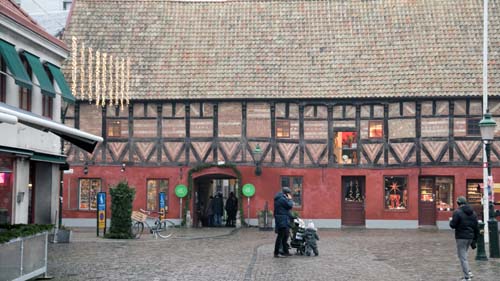 the Lejonet pharmacy here. The building dates from 1896 and was built in
the new renaissance style. Teschska palatset as the building is
officially called was built by order of pharmacist John Tesch. The
architects were Lindvall and Boklund. It was one of the largest p
the Lejonet pharmacy here. The building dates from 1896 and was built in
the new renaissance style. Teschska palatset as the building is
officially called was built by order of pharmacist John Tesch. The
architects were Lindvall and Boklund. It was one of the largest p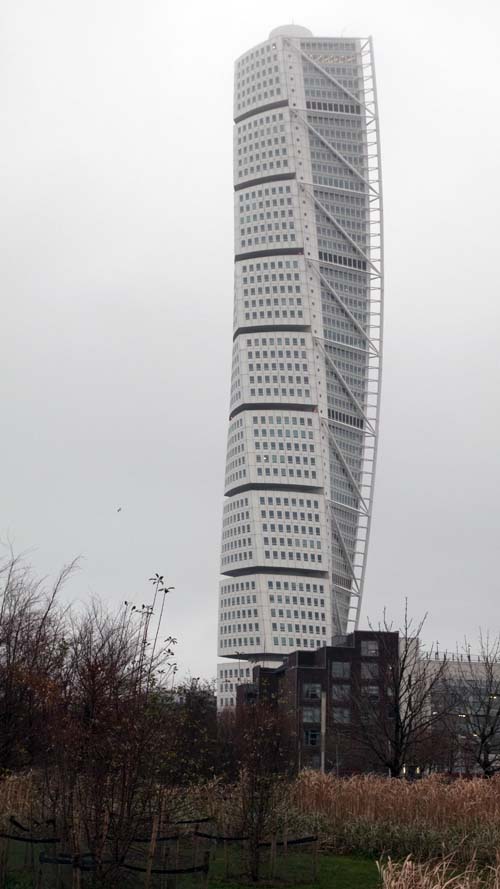 harmacies
in Europe at the time. We continue to the St Petrikerk, which is
unfortunately closed. The church was inaugurated in the beginning of the
14th century and was expanded a number of times. We walk through the
center of the city and buy some clothing accessories at Åhlén
. We cross the big Gustaf Adolf torg, where a Christmas market has been
set up. Then walk back through the city to the Saluhall.
This market hall has been located in a former railway warehouse since
2014, which had been vacant since 1955. Here we have an Italian lunch.
In a new housing estate on the banks of the Sound, the 190 meter high
residential tower Turning Torso has been present since 2005. It
is a slender, twisted tower designed by the Spanish architect Calatrava.
Its form i
harmacies
in Europe at the time. We continue to the St Petrikerk, which is
unfortunately closed. The church was inaugurated in the beginning of the
14th century and was expanded a number of times. We walk through the
center of the city and buy some clothing accessories at Åhlén
. We cross the big Gustaf Adolf torg, where a Christmas market has been
set up. Then walk back through the city to the Saluhall.
This market hall has been located in a former railway warehouse since
2014, which had been vacant since 1955. Here we have an Italian lunch.
In a new housing estate on the banks of the Sound, the 190 meter high
residential tower Turning Torso has been present since 2005. It
is a slender, twisted tower designed by the Spanish architect Calatrava.
Its form i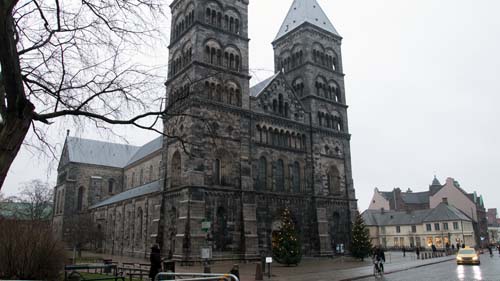 s
based on a sculpture by Calatrava, whose shoulders are turned relative
to the base.
s
based on a sculpture by Calatrava, whose shoulders are turned relative
to the base.
Then we drive to Lund, about 19km north of Malmö. It is an old university
town (1666) with 39,000 students and a 12th century cathedral. We also
visit the market hall here and drink coffee accompanied by a Swedish
delicacy at Konditori Ramklints
at the Mårtenstorget. Around 15.30 we drive back to the bridge. We cross
the bridge again into Denmark and drive back to the apartment.
In the evening we bring the car back to Sixt and we go for a cocktail at
Curfew in Vesterbro. It is a beautiful bar with the theme of the
period of the Prohibition in the US, when alcohol was illegal and bars
were in the hands of organized crime. Then we eat in the Kødbyen,
the former meat district. Many of the abattoirs and sheds in this
district have been converted into restaurants and bars. The Paté
Paté restaurant is packed, but the bistro food (small dishes)
tastes excellent. Then back home by train and bus.
Weather: 5 ° and very cloudy. In the afternoon some rain during the ride
to Lund
Sunday 2 December 2018
The downstairs neig hbors
celebrate a birthday party and that involves a lot of noise. Loud music,
lots of shouting. At 2 o'clock in the morning I am fed up with it and go
downstairs to demand that the music is turned off. I threaten to call the
police if they don't. And wonder to wonder, after a few minutes the music
is off and after five minutes it is completely silent. We can finally get
some sleep.
hbors
celebrate a birthday party and that involves a lot of noise. Loud music,
lots of shouting. At 2 o'clock in the morning I am fed up with it and go
downstairs to demand that the music is turned off. I threaten to call the
police if they don't. And wonder to wonder, after a few minutes the music
is off and after five minutes it is completely silent. We can finally get
some sleep.The next morning after breakfast we take the bus and metro to the Christianshavn district. We drink coffee at the Lagkagehuset (Cake building). A coffee shop in the building of the same name. The modernist building from 1930 derives its name from the resemblance with a layered cake. The bakery and coffee shop now has outlets in many places in Copenhagen and even in other Danish cities under that name. After the coffee we walk past the docks and canals of Christianshavn. The resemblance with Amsterdam and the Netherlands is no c
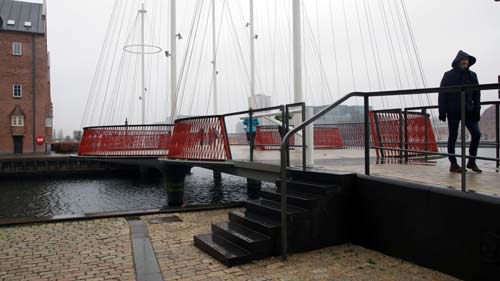 oincidence,
because a Dutch land surveyor and engineer, Johan Semp, was commissioned
by Christian IV for the design of this 17th century city district on
reclaimed land. In 1625 the district was completed and Semp (or Sems) left
for his native Groningen. We walk past the Vor Frelser Kirke. This
church is special because of the spiral staircase on the outside of the
spire. It was built at the end of the 17th century under Christian V, the
first absolute ruler of Denmark. We walk on and come along the
Nordatlantens Brygge, where we see 108, the restaurant where we ate the
day before yesterday. It is located in a former warehouse. We cross a
bridge and walk past even more former warehouses and a naval base. The
neofuturistic opera house was built on the former naval grounds in 2005
after a design by Henning Larssen. It is one of the most modern, but also
most expensive (more than 500,000 euros) in the world. The building was
financed by the culture foundation of A.P.
Møller, the founder of the shipping company Mærsk, the largest
shipping company in the world. The opera
house is perfectly aligned with the marble church and the
royal palace Amalienborg on the other side o
oincidence,
because a Dutch land surveyor and engineer, Johan Semp, was commissioned
by Christian IV for the design of this 17th century city district on
reclaimed land. In 1625 the district was completed and Semp (or Sems) left
for his native Groningen. We walk past the Vor Frelser Kirke. This
church is special because of the spiral staircase on the outside of the
spire. It was built at the end of the 17th century under Christian V, the
first absolute ruler of Denmark. We walk on and come along the
Nordatlantens Brygge, where we see 108, the restaurant where we ate the
day before yesterday. It is located in a former warehouse. We cross a
bridge and walk past even more former warehouses and a naval base. The
neofuturistic opera house was built on the former naval grounds in 2005
after a design by Henning Larssen. It is one of the most modern, but also
most expensive (more than 500,000 euros) in the world. The building was
financed by the culture foundation of A.P.
Møller, the founder of the shipping company Mærsk, the largest
shipping company in the world. The opera
house is perfectly aligned with the marble church and the
royal palace Amalienborg on the other side o f
the harbor. It is a beautiful location. From the opera we take the water
bus to the Circle Bridge by the Icelandic artist Olafur Eliasson.
It consists of three connected circles, each with a sailing mast. The
bridge is for cyclists and pedestrians, who have to make a circular
movement to cross the bridge.
f
the harbor. It is a beautiful location. From the opera we take the water
bus to the Circle Bridge by the Icelandic artist Olafur Eliasson.
It consists of three connected circles, each with a sailing mast. The
bridge is for cyclists and pedestrians, who have to make a circular
movement to cross the bridge.We walk through the pouring rain to the metro and take it to Nørreport and from there the bus to Georg Brandes Plads near the Park Museums. We walk to the Rosenborg castle. This fairytale castle, with Dutch bell gables, was built in the 17th century as a summer residence for Christian IV and remained a royal residence until 1838 when it was opened to the public. The main attraction are the Danish crown jewels, which are displayed in the cellar vault. In the palace itself, the art treasures, dinnerware, clothing and much more of the royal family are exhibited. On the top floor is the long hall with the Danish throne, which is used for coronations of incoming Danish monarchs. The palace is very dark. There is little light coming in, especially with this gloomy weather and there is also little artificial light in order to protect the collection from the effects of light. It is so dark here and there that at times you ha
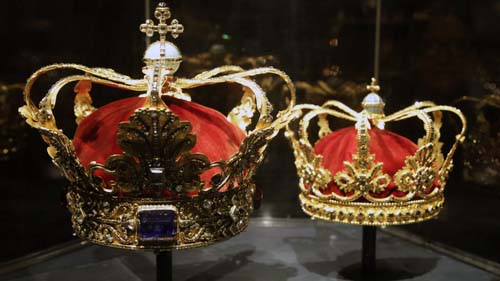 rdly
see what you're looking at. Access is strictly regulated with time slots
before entering. In front of the palace and the treasury, real Danish
armed soldiers are on guard.
rdly
see what you're looking at. Access is strictly regulated with time slots
before entering. In front of the palace and the treasury, real Danish
armed soldiers are on guard.After the visit to Rosenborg we return to the apartment and have lunch. We rest a bit and go to the airport by bus and metro around 3 pm. We drop off our suitcases, go through the security check and then take some food. The offer is overwhelming. Many restaurants and shops in the departure halls. We suddenly see that the seats we had reserved were not the same as on our boarding cards, which we got when we dropped off the baggage. We complain at the gate and do get our desired seats at the exit row. The aircraft (scheduled departure 18.05) has to wait 45 minutes to leave, because no landing slot is available at Amsterdam Airport Schiphol. In the end, we are only 30 minutes late. The train arrives on time and at Rotterdam Central the Uber taxi is waiting for us. Half past ten we are back at home.
Weather: 5 ° C rain.
| Other Travel | ||